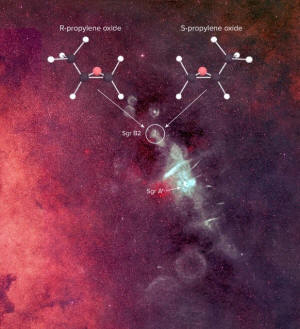|
Asymmetric molecule, key to life,
detected in space for first time
 Send a link to a friend
Send a link to a friend
 [June 18, 2016]
By Irene Klotz [June 18, 2016]
By Irene Klotz
CAPE CANAVERAL, Fla. (Reuters) -
Scientists for the first time have found a complex organic molecule in
space that bears the same asymmetric structure as molecules that are key
to life on Earth
The researchers said on Tuesday they detected the complex organic
molecule called propylene oxide in a giant cloud of gas and dust
near the center of the Milky Way galaxy.
Akin to a pair of human hands, certain organic molecules including
propylene oxide possess mirror-like versions of themselves, a
chemical property called chirality. Scientists have long pondered
why living things make use of only one version of certain molecules,
such as the "right-handed" form of the sugar ribose, which is the
backbone of DNA.
The discovery of propylene oxide in space boosts theories that
chirality has cosmic origins.
"It is a pioneering leap forward in our understanding of how
prebiotic molecules are made in the universe and the effects they
may have on the origins of life," chemist Brett McGuire of the
National Radio Astronomy Observatory in Charlottesville, Virginia
said in a statement.
These types of molecules, vital for biology, previously have been
discovered in meteorites on Earth and in comets in our own solar
system but never before in the enormous expanse of interstellar
space.
The findings boost the notion that the chemical building blocks for
life were delivered to Earth early in its history by celestial
bodies like meteorites and comets that incorporated such molecules
from space.
In May, researchers for the first time found the amino acid glycine,
used by living organisms to make proteins, on a comet.
The scientists in the new study used radio telescopes to ferret out
the chemical details of molecules in the distant, star-forming cloud
of gas and dust. As molecules move around in the vacuum of space
they emit telltale vibrations that appear as distinctive radio
waves.
The complex signals tied to propylene oxide were not precise enough
for the researchers to determine whether the molecules were
orientated to the left or to the right.
[to top of second column] |

A depiction of the complex organic molecule propylene oxide is seen
over a background image of the center of the Milky Way galaxy in an
undated composite image provided by the U.S. National Radio
Astronomy Observatory. Scientists said on Tuesday they detected
propylene oxide near the center of our Galaxy in Sagittarius. B.
Saxton, NRAO/AUI/NSF from data provided by N.E. Kassim, Naval
Research Laboratory, Sloan Digital Sky Survey/Handout via Reuters

Like a hand's shadow, "it's impossible to tell if the left or the
right hand is casting the shadow," said California Institute of
Technology chemistry graduate student Brandon Carroll.
Future studies of how polarized light interacts with the molecules
may reveal if one version of propylene oxide dominates in space, the
researchers said.
The research was published in the journal Science. The scientists
presented it on Tuesday at the American Astronomical Society meeting
in San Diego.
(Reporting by Irene Klotz; Editing by Will Dunham)
[© 2016 Thomson Reuters. All rights
reserved.]
Copyright 2016 Reuters. All rights reserved. This material may not be published,
broadcast, rewritten or redistributed. |